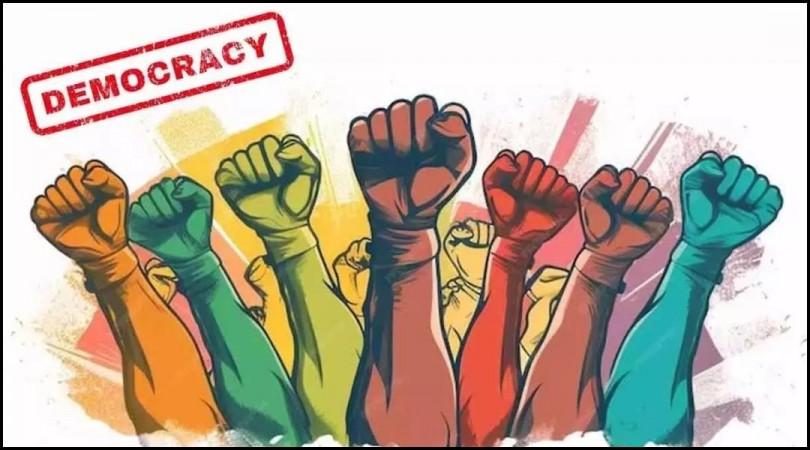
Victor Klemperer, the German-Jewish philologist who chronicled the Nazi rise to power in his searing diaries, captured something profoundly unsettling: democracies rarely die with a single dramatic blow. Instead, they decay slowly, from within, while citizens convince themselves that everything remains normal. He wrote of how, step by step, language was corrupted, institutions were co-opted, and truth was replaced with propaganda. Klemperer's central warning resonates with chilling relevance today: "Language does not simply write and think for me, it also increasingly dictates my feelings and governs my entire spiritual being."
Almost a century later, the very forces Klemperer described weaponized language, compliant media, manipulative nationalism are unfolding across continents. From Beijing to Washington, Colombo to Kathmandu, Dhaka to New Delhi, we see how democratic erosion is no longer an abstract threat but a lived, global reality.
This analysis traces these patterns, examines case studies, and looks forward to the unique role of youth in shaping the future.
The Anatomy of Decay: How Democracies Unravel
Democracy rarely collapses overnight. Its erosion follows a discernible sequence, like a disease with identifiable stages.
By expanding Klemperer's insights and integrating the work of modern thinkers such as Timothy Snyder (On Tyranny), Fareed Zakaria (The Future of Freedom), and Steven Levitsky and Daniel Ziblatt (How Democracies Die), five critical fault lines emerge.
1. Language as a Weapon of Division
Klemperer meticulously documented how the Nazis reshaped German language to normalize hate and make authoritarianism feel natural. Today, the digital age has multiplied this effect a thousandfold.
Political actors across continents use hashtags, memes, and emotional slogans to stoke fear and resentment. Terms like "anti-national," "traitor," or "urban terrorist" are not mere insults they are tools for delegitimizing dissent without engaging in substantive debate.
"If you want to control people, begin by controlling the words they use." – George Orwell
Social media algorithms turbocharge this weaponization by prioritizing outrage over reason. A false narrative, once amplified, becomes almost impossible to counter. The storming of the U.S. Capitol on January 6, 2021, was a direct consequence of such weaponized language.
The same phenomenon drives sectarian hate in South Asia, race-based extremism in Europe, and populist surges worldwide. Once citizens lose a shared vocabulary for truth, they can no longer have a meaningful democratic conversation.
2. Capture and Hollowing of Institutions
Democracy depends not only on elections but also on robust independent institutions courts, election commissions, universities, regulatory bodies. When these institutions are bent to serve the ruling elite, democracy's guardrails collapse.
Appointments are increasingly politicized, oversight bodies packed with loyalists, and dissenters sidelined through coercion or fabricated cases.
"Institutions don't protect themselves; they are protected by citizens who believe in them." – Timothy Snyder
We have seen this vividly in Turkey, Hungary, and parts of South Asia, where institutional decay breeds public apathy. Citizens who no longer trust courts or election systems either disengage entirely or turn to authoritarian "strongmen" who promise order. This dynamic has played out in Pakistan, where military dominance and weak civilian institutions have created a cycle of coups and crises.
3. Weaponized Misinformation and the Fog of Falsehoods
In Klemperer's time, propaganda was centralized through radio and print. Today, it is decentralized and far more dangerous.
Bot armies, deepfakes, and coordinated disinformation campaigns create alternate realities. In such a landscape, even basic facts such as election outcomes or public health data become contested.
"A lie can travel halfway around the world while the truth is still putting on its shoes." – Mark Twain
Misinformation is now not merely a byproduct of politics; it is a deliberate strategy. Russia's interference in Western elections, Myanmar's online hate campaigns fueling Rohingya violence, and even grassroots WhatsApp groups spreading fake news in South Asia all demonstrate how digital disinformation has become a weapon of mass manipulation.
Citizens overwhelmed by contradictory narratives often retreat into cynicism, making them more susceptible to simplistic authoritarian messaging.
4. Erosion of Media Independence
Klemperer observed how Germany's press became either silenced or complicit. Today, a similar process is unfolding worldwide.
Media houses are captured through corporate takeovers, regulatory intimidation, or economic dependence on government advertising. Some journalists are harassed or imprisoned, while others engage in self-censorship to survive.
"A free press is not a privilege, it is a necessity in any democracy." – Walter Cronkite
In Beijing, state-controlled outlets function as pure propaganda organs.
In the U.S., parts of the media ecosystem have become hyper-partisan, amplifying political tribalism rather than exposing corruption.
In South Asia, channels that once challenged power have become megaphones for ruling ideologies. When truth-tellers are silenced, citizens are left without a common reality, accelerating democratic decline.
5. Exploitation of Religion and Hard Nationalism
Perhaps the most potent accelerant of democratic erosion is the fusion of religious identity with extreme nationalism.
Leaders position themselves as defenders of both faith and nation, turning political opposition into moral treason.
Once this dynamic takes hold, rational debate is replaced by emotional fervor, and opponents are cast not merely as rivals but as existential threats.
"When fascism comes to America, it will be wrapped in the flag and carrying a cross." – Sinclair Lewis
History offers stark warnings:
The Nazis fused racial ideology with nationalism to justify totalitarianism.
Sri Lanka's Sinhala-Buddhist nationalism fueled decades of civil war.
Pakistan's state-sponsored religious identity has repeatedly destabilized governance.
Even in Western democracies, coded religious appeals have reshaped party ideologies.
This exploitation is particularly dangerous because it mobilizes the deepest human emotions fear of cultural loss, yearning for belonging and ties them to authoritarian projects.
Global Echoes: When People Rise Against Decay
While these five forces can entrench authoritarianism, they also plant the seeds of revolt. Across Asia and beyond, we see how regimes that exploit religion, nationalism, and disinformation eventually face a popular backlash.
Sri Lanka (2022): The Rajapaksa dynasty, long sustained by nationalist rhetoric and patronage networks, collapsed amid mass protests triggered by economic collapse and public anger over corruption.
Pakistan: The country cycles between military dominance, populist surges, and civilian failures. Each actor uses nationalism and religious rhetoric, only to eventually face public exhaustion and uprisings.
Bangladesh: Alternating waves of authoritarian stability and violent street protests illustrate the fragile balance between control and chaos.
Nepal: Decades of public frustration with monarchy and elite capture culminated in massive movements that toppled rulers and reshaped the constitution.
In each case, citizens initially embraced populist leaders promising salvation.
But when rhetoric failed to match reality, people reclaimed the streets.
This shows that while authoritarianism can rise, it is never invincible.
Beijing and the Totalitarian Model
China represents a more chilling trajectory.
Through a combination of total media control, advanced surveillance, and algorithmic censorship, Beijing has created a model of digital authoritarianism.
Unlike fragile regimes, this system does not fear public uprisings because it can preempt dissent through predictive policing and omnipresent surveillance.
"The new tools of repression are invisible, personalized, and data-driven." – Shoshana Zuboff
This model is increasingly exported to other regimes, from Myanmar to parts of Africa, showing how technology can entrench authoritarianism even more deeply than old-school propaganda ever could.
America: Polarization and Institutional Stress
The United States, long considered a beacon of democracy, now faces its most profound internal challenge since the Civil War. Polarized media ecosystems, rampant misinformation, and the weaponization of identity politics have eroded trust in institutions.
The Capitol riots of January 6, 2021, were not an isolated event but a symptom of deeper decay.
"Democracies usually die not at the hands of generals but through the actions of elected leaders." – Levitsky & Ziblatt
The coming U.S. elections will test whether democratic norms can recover or whether polarization will lead to a slow-motion unraveling.
India: Two Decades of Transformation
India, the world's largest democracy, stands at a crossroads.
Over the past two decades and especially the last ten years the following trends have intensified:
Language: Political discourse has grown increasingly polarized, with labels like "anti-national" deployed to silence dissent.
Institutions: Critics allege that several independent bodies have been compromised, raising questions about checks and balances.
Media: While some outlets remain courageous, many have been co-opted or intimidated, fostering a climate of self-censorship.
Religion and Nationalism: Religion has moved to the center of political strategy, mobilizing vast voter blocs but also deepening societal divisions.
Digital Propaganda: WhatsApp groups, social media campaigns, and now AI-driven misinformation have transformed the electoral battlefield.
India's resilience lies in its vibrant civil society and history of democratic struggle.
However, the next decade will determine whether these counter-forces can reverse current trends or whether the nation will face a deeper democratic crisis.
Youth: Majority Stakeholders, Maximum Consequences
Today's youth are the majority stakeholders in democracy.
They possess the longest residual life span, meaning they will face the consequences of political decay for the greatest number of years.
Their choices today will shape the world they inherit tomorrow.
"The future is not something we enter. The future is something we create." – Leonard Sweet
What the youth must do:
1. Develop Digital Literacy: Learn to question sources, verify information, and resist manipulation by deepfakes and propaganda.
2. Engage Actively: Move beyond online outrage to real-world civic participation voting, volunteering, organizing.
3. Hold Institutions Accountable: Demand transparency and reform, especially in education, media, and governance.
4. Bridge Divides: Resist simplistic nationalist or religious narratives by fostering dialogue across differences.
5. Innovate for Democracy: Harness technology not just for profit but for strengthening participatory governance and combating disinformation.
If the youth remain passive spectators, they risk becoming the generation that watched democracy die.
If they rise, they can be its most powerful saviors.
A Call to Vigilance
Victor Klemperer's diaries remind us that democracy dies not with a bang but with a series of quiet surrenders. Across the world today, from Beijing's digital totalitarianism to America's polarized gridlock and South Asia's turbulent politics, the same patterns repeat: language weaponised, institutions captured, media co-opted, truth replaced with lies, and religion fused with nationalism.
The challenge is immense but not insurmountable.
Citizens, especially the youth, must reclaim their role as active stewards of democracy. For as Klemperer's life teaches, tyranny thrives not merely on the actions of the powerful, but on the silence of the many.
The question is no longer whether democracy is at risk. The question is whether we have the courage and imagination to defend it before it is too late.
[Major General Dr. Dilawar Singh, IAV, is a distinguished strategist having held senior positions in technology, defence, and corporate governance. He serves on global boards and advises on leadership, emerging technologies, and strategic affairs, with a focus on aligning India's interests in the evolving global technological order.]

















